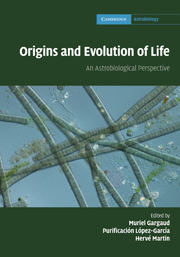Book contents
- Frontmatter
- Contents
- List of contributors
- Foreword
- Preface
- Part I What is life?
- Part II Astronomical and geophysical context of the emergence of life
- Part III The role of water in the emergence of life
- Part IV From non-living systems to life
- Part V Mechanisms for life evolution
- Part VI Life in extreme conditions
- Part VII Traces of life and biosignatures
- Part VIII Life elsewhere?
- 29 Titan and the Cassini–Huygens mission
- 30 The role of terrestrial analogue environments in astrobiology
- Index
30 - The role of terrestrial analogue environments in astrobiology
from Part VIII - Life elsewhere?
Published online by Cambridge University Press: 04 February 2011
- Frontmatter
- Contents
- List of contributors
- Foreword
- Preface
- Part I What is life?
- Part II Astronomical and geophysical context of the emergence of life
- Part III The role of water in the emergence of life
- Part IV From non-living systems to life
- Part V Mechanisms for life evolution
- Part VI Life in extreme conditions
- Part VII Traces of life and biosignatures
- Part VIII Life elsewhere?
- 29 Titan and the Cassini–Huygens mission
- 30 The role of terrestrial analogue environments in astrobiology
- Index
Summary
Introduction
Because Earth is the only place where we are certain that life exists, the characteristics of terrestrial life underpin our search for life elsewhere. In essence, the search for extraterrestrial life begins here on Earth. In the mid-twentieth century, early astrobiologists had recognized this reality and began studying life in remote and extreme environments that could be considered as analogues to places on Mars or elsewhere (e.g. Kooistra et al., 1958; Cameron, 1963; Briot et al., 2004). Early work by NASA and the Jet Propulsion Laboratory included studies of arid-soil microbiology in various locations, including the Atacama Desert and the Antarctic Dry Valleys (Cameron et al., 1966; Cameron, 1969; Horowitz et al., 1969; Cameron et al., 1970). Testing of NASA's earliest life-detection instruments also took place at these and other extreme environments (Levin et al., 1962; Levin and Heim, 1965). In parallel, microbiologists were also studying experimentally the survivability and adaptation of microorganisms isolated from desert soils and exposed to Lunar and Martian conditions in the context of forward contamination of the Moon and Mars, as well as towards the possibility of the existence of extraterrestrial life (e.g. Fulton, 1958; Kooistra et al., 1958; Davis and Fulton, 1959; Packer et al., 1963).
In recent years, Earth-based microbiological research, especially in harsh or extreme environments, has greatly expanded our understanding of the nature and limits of life (e.g. Rothschild and Mancinelli, 2001; Steven et al., 2006; Pikuta et al., 2007; Southam et al., 2007).
- Type
- Chapter
- Information
- Origins and Evolution of LifeAn Astrobiological Perspective, pp. 507 - 522Publisher: Cambridge University PressPrint publication year: 2011
- 3
- Cited by



